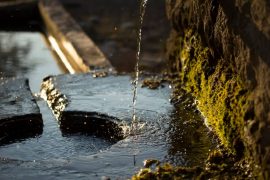Groundwater accounts for 99% of the world’s liquid freshwater and plays a critical role in the hydrologic cycle, despite being hidden beneath the surface. Wetlands, rivers, and lakes are surface manifestations of groundwater that exchange water with the groundwater reservoir from which they receive water when they need it and from which they withdraw some of their water when surface water is plentiful.
What is groundwater?
Groundwater is the water that is present in the cavities of the rock beneath the earth’s surface, and it is also the water in the saturated aquifer beneath the water table in a narrower sense.
There are three types of groundwater, as popularly known: first, it refers to the total amount of water buried in the groundwater, which is distinct from surface water, particularly the proportion of water in the aquifer’s saturated zone; Second, water that replenishes springs and wells; and thirdly, it refers to the water contained in underground rock cavities, specifically those that comprise the crustal material.
Groundwater is a critical component of water supply. It is a major source of water for agriculture, industry, mining, and cities. This is due to its consistent water supply and excellent water quality. Under certain conditions, however, changes in groundwater can result in negative natural occurrences such as land subsidence, swapping, landslides, and salinization.
Why groundwater is important?
Humans rely heavily on groundwater as a source of water. Groundwater serves as a source of drinking water for up to half of the world’s population, and it also provides 43 percent of all irrigation water. 2.5 billion people around the world rely exclusively on groundwater resources to meet their basic daily water needs.
The population of the Earth is expected to rise to 11 billion by 2100, up from nearly 8 billion in 2020. Humans will need to devise a means of producing enough food without depleting the climate, soil, or water. This is the most difficult problem humanity has ever encountered. The solution lies in sustainable groundwater management. It’s critical to have a scientific understanding of groundwater and to manage it properly, because if we use and replenish it responsibly, groundwater can mitigate this problem.
What is groundwater contamination?
Groundwater pollution is primarily caused by industrial, agricultural, and domestic sources, such as mines and oil and gas extraction; industrial production discharges wastewater, exhaust fumes, and waste residues; agricultural production discharges fertilizers, pesticides, wastewater irrigation, treated water irrigation, pipe network leakage, and landfills; and domestic production discharges fertilizers, pesticides, wastewater irrigation, treated water irrigation, pipe network leakage, and landfills, etc. Pollution of groundwater affects the soil and other water bodies, and one of the characteristics of groundwater is that it remains hidden, is stored for a long time, and is difficult to remediate. Groundwater treatment presents challenges in obtaining groundwater quality samples, identifying pollution sources, and meeting technical analysis requirements. Even if the source of pollution is completely eliminated, it will take a long time for groundwater quality to recover.
What is groundwater contamination remediation?
The process of removing contaminants from polluted groundwater is called groundwater remediation. Although most groundwater is clean, it can be contaminated by the overuse of fertilizers or pesticides, spills from industrial operations, runoff, or leaks from landfills. Contaminated groundwater is dangerous to people’s health, so groundwater remediation is necessary to address these problems.
What are the different methods of groundwater contamination?
When it comes to groundwater remediation, there are numerous methods and techniques to choose from. Biological, chemical and physical methods are the three most common groundwater remediation methods.
Biological
To clean contaminated groundwater, this technique uses microorganisms, organic material and plants. Biosparging, bioventing, and bioaugmentation are three methods of breaking down chemicals and compounds in groundwater using biological material. A biological method has the advantage that the contaminated water does not have to be removed to be treated.
Chemical
Chemical remediation can be achieved by chemical precipitation, oxidation, ion exchange, and carbon absorption, among other methods. This method may take longer or be more expensive but may be the only option for certain contaminants.
Physical
In this technique, groundwater is physically extracted from the aquifer and then treated at the surface. Contaminants are removed by technologies such as carbon absorption or air stripping after the groundwater is brought to the surface. The main advantage of this method is that it reduces the concentration of the contaminant plume while controlling the migration of the contaminant plume.
